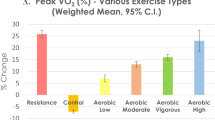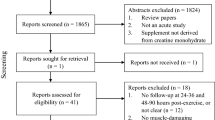Abstract
The aim of the present study was to evaluate the effect of exercise training (ET) and l-arginine on oxidative stress and ventricular function in rat with myocardial infarction (MI). Four weeks after the surgical procedures, 40 Wistar male rats were randomized to the following groups: MI-sedentary (Sed); MI-exercise (Ex); MI-sedentary + l-arginine (Sed + LA); and MI-exercise + l-arginine (Ex + LA); the rats were subjected to aerobic training in the form of treadmill running. Rats in the l-arginine-treated groups drank water containing 4 % l-arginine. Before and after the training program, all subjects underwent resting echocardiography. Catalase (CAT) glutathione peroxidase (GPx), malondialdehyde (MDA) and myeloperoxidase (MPO) were measured. Cardiac output, stroke volume and fractional shortening in Ex and Ex + LA groups significantly increased in comparison with the Sed group. Cardiac systolic function indices in Ex + LA group were significantly greater than Ex group. Also, GPx activity and MDA, respectively, increased and decreased in response to ET, but no change was observed in MPO and CAT. These results suggest that ET increased LV function by decreasing oxidative stress and increasing antioxidant defense system in rats with MI. In addition in response to training, l-arginine appears to have additive effect on cardiac function, but have no effect on oxidative stress indices.
Similar content being viewed by others
References
Brown, D. A., Jew, K. N., Sparagna, G. C., Musch, T. I., & Moore, R. L. (2003). Exercise training preserves coronary flow and reduces infarct size after ischemia-reperfusion in rat heart. Journal of Applied Physiology, 95, 2510–2518.
Takimoto, E., & Kass, D. A. (2007). Role of oxidative stress in cardiac hypertrophy and remodeling. Hypertension, 49, 241–248.
Zhang, M., & Shah, A. M. (2007). Role of reactive oxygen species in myocardial remodeling. Current Heart Failure Reports, 4, 26–30.
Evran, B., Karpuzoğlu, H., Develi, S., Kalaz, E. B., Soluk-Tekkeşin, M., Olgaç, V., et al. (2014). Effects of carnosine on prooxidant–antioxidant status in heart tissue, plasma and erythrocytes of rats with isoproterenol-induced myocardial infarction. Pharmacological Reports, 66, 81–86.
Shiomi, T., Tsutsui, H., Matsusaka, H., Murakami, K., Hayashidani, S., Ikeuchi, M., et al. (2004). Overexpression of glutathione peroxidase prevents left ventricular remodeling and failure after myocardial infarction in mice. Circulation, 109, 544–549.
Xu, X., Zhao, W., Lao, S., Wilson, B. S., Erikson, J. M., & Zhang, J. Q. (2010). Effects of exercise and l-arginine on ventricular remodeling and oxidative stress. Medicine and Science in Sports and Exercise, 42, 346.
Hill, M. F., & Singal, P. K. (1996). Antioxidant and oxidative stress changes during heart failure subsequent to myocardial infarction in rats. The American Journal of Pathology, 148, 291.
Fukui, T., Yoshiyama, M., Hanatani, A., Omura, T., Yoshikawa, J., & Abe, Y. (2001). Expression of p22-phox and gp91-phox, essential components of NADPH oxidase, increases after myocardial infarction. Biochemical and Biophysical Research Communications, 281, 1200–1206.
Leeuwenburgh, C., Hansen, P. A., Holloszy, J. O., & Heinecke, J. W. (1999). Hydroxyl radical generation during exercise increases mitochondrial protein oxidation and levels of urinary dityrosine. Free Radical Biology and Medicine, 27, 186–192.
Ahmadiasl, N., Soufi, F. G., Alipour, M., Bonyadi, M., Sheikhzadeh, F., Vatankhah, A., et al. (2007). Effects of age increment and 36-week exercise training on antioxidant enzymes and apoptosis in rat heart tissue. Journal of Sports Science and Medicine, 6, 243.
Rastaldo, R., Pagliaro, P., Cappello, S., Penna, C., Mancardi, D., Westerhof, N., & Losano, G. (2007). Nitric oxide and cardiac function. Life Sciences, 81, 779–793.
Mendes-Ribeiro, A. C., Mann, G. E., de Meirelles, L. R., Moss, M. B., Matsuura, C., & Brunini, T. M. C. (2009). The role of exercise on l-arginine nitric oxide pathway in chronic heart failure. The Open Biochemistry Journal, 3, 55.
Lin, W.-T., Yang, S.-C., Chen, K.-T., Huang, C.-C., & Lee, N.-Y. (2005). Protective effects of l-arginine on pulmonary oxidative stress and anti-oxidant defenses during exhaustive exercise in rats. Acta Pharmacologica Sinica, 26, 992–999.
Fukahori, M., Ichimori, K., Ishida, H., Nakagawa, H., & Okino, H. (1994). Nitric oxide reversibly suppresses xanthine oxidase activity. Free Radical Research, 21, 203–212.
Linke, A., Adams, V., Schulze, P. C., Erbs, S., Gielen, S., Fiehn, E., et al. (2005). Antioxidative effects of exercise training in patients with chronic heart failure increase in radical scavenger enzyme activity in skeletal muscle. Circulation, 111, 1763–1770.
Jain, M., Liao, R., Ngoy, S., Whittaker, P., Apstein, C. S., & Eberli, F. R. (2000). Angiotensin II receptor blockade attenuates the deleterious effects of exercise training on post-MI ventricular remodelling in rats. Cardiovascular Research, 46, 66–72.
Veiga, E. C. D. A., Portes, L. A., Bocalini, D. S., Antonio, E. L., Santos, A. A. D., Santos, M. H., et al. (2013). Cardiac implications after myocardial infarction in rats previously undergoing physical exercise. Arquivos Brasileiros de Cardiologia, 100, 37–43.
Bansal, A., Dai, Q., Chiao, Y. A., Hakala, K. W., Zhang, J. Q., Weintraub, S. T., & Lindsey, M. L. (2010). Proteomic analysis reveals late exercise effects on cardiac remodeling following myocardial infarction. Journal of Proteomics, 73, 2041–2049.
Xu, X., Wan, W., Powers, A. S., Li, J., Ji, L. L., Lao, S., et al. (2008). Effects of exercise training on cardiac function and myocardial remodeling in post myocardial infarction rats. Journal of Molecular and Cellular Cardiology, 44, 114–122.
Suzuki, J. (2005). Microvascular angioadaptation after endurance training with l-arginine supplementation in rat heart and hindleg muscles. Experimental Physiology, 90, 763–771.
Briet, F., Keith, M., Leong-Poi, H., Kadakia, A., Aba-Alkhail, K., Giliberto, J.-P., et al. (2008). Triple nutrient supplementation improves survival, infarct size and cardiac function following myocardial infarction in rats. Nutrition, Metabolism and Cardiovascular Diseases, 18, 691–699.
Paglia, D. E., & Valentine, W. N. (1967). Studies on the quantitative and qualitative characterization of erythrocyte glutathione peroxidase. The Journal of Laboratory and Clinical Medicine, 70, 158–169.
Aebi, H. (1984). Catalase in vitro. Methods in Enzymology, 105, 121–126.
Niehaus, W. G., & Samuelsson, B. (1968). Formation of malonaldehyde from phospholipid arachidonate during microsomal lipid peroxidation. European Journal of Biochemistry, 6, 126–130.
Mullane, K. M., Kraemer, R., & Smith, B. (1985). Myeloperoxidase activity as a quantitative assessment of neutrophil infiltration into ischemie myocardium. Journal of Pharmacological Methods, 14, 157–167.
Belcastro, A. N., Arthur, G. D., Albisser, T. A., & Raj, D. A. (1996). Heart, liver, and skeletal muscle myeloperoxidase activity during exercise. Journal of Applied Physiology, 80, 1331–1335.
Huang, C.-C., Huang, C.-C., Lin, T. J., Lin, T.-J., Lu, Y. F., Lu, Y.-F., et al. (2009). Protective effects of l-arginine supplementation against exhaustive exercise-induced oxidative stress in young rat tissues. Chinese Journal of Physiology, 52, 306–315.
Yamashita, N., Hoshida, S., Otsu, K., Asahi, M., Kuzuya, T., & Hori, M. (1999). Exercise provides direct biphasic cardioprotection via manganese superoxide dismutase activation. The Journal of Experimental Medicine, 189, 1699–1706.
Somani, S. M., Frank, S., & Rybak, L. P. (1995). Responses of antioxidant system to acute and trained exercise in rat heart subcellular fractions. Pharmacology, Biochemistry and Behavior, 51, 627–634.
Husain, K., & Hazelrigg, S. R. (2002). Oxidative injury due to chronic nitric oxide synthase inhibition in rat: effect of regular exercise on the heart. Biochimica et Biophysica Acta (BBA)-Molecular Basis of Disease, 1587, 75–82.
Powers, S. K., Quindry, J. C., & Kavazis, A. N. (2008). Exercise-induced cardioprotection against myocardial ischemia—reperfusion injury. Free Radical Biology and Medicine, 44, 193–201.
Ramkumar, V., Nie, Z., Rybak, L. P., & Maggirwar, S. B. (1995). Adenosine, antioxidant enzymes and cytoprotection. Trends in Pharmacological Sciences, 16, 283–285.
Finkel, T. (1999). Signal transduction by reactive oxygen species in non-phagocytic cells. Journal of Leukocyte Biology, 65, 337–340.
Sorescu, D., & Griendling, K. K. (2002). Reactive oxygen species, mitochondria, and NAD (P) H oxidases in the development and progression of heart failure. Congestive Heart Failure, 8, 132–140.
Servais, S., Couturier, K., Koubi, H., Rouanet, J. L., Desplanches, D., Sornay-Mayet, M. H., et al. (2003). Effect of voluntary exercise on H2O2 release by subsarcolemmal and intermyofibrillar mitochondria. Free Radical Biology and Medicine, 35, 24–32.
Sen, C. K., & Packer, L. (1996). Antioxidant and redox regulation of gene transcription. The FASEB Journal, 10, 709–720.
Meyer, M., Pahl, H. L., & Baeuerle, P. A. (1994). Regulation of the transcription factors NF-κB and AP-1 by redox changes. Chemico-Biological Interactions, 91, 91–100.
Rubino, A., & Yellon, D. M. (2000). Ischaemic preconditioning of the vasculature: an overlooked phenomenon for protecting the heart? Trends in Pharmacological Sciences, 21, 225–230.
Petry, E., Cruzat, V., Heck, T., Homem, D. B. P, Jr, & Tirapegui, J. (2014). l-glutamine supplementations enhance liver glutamine-glutathione axis and heat shock factor-1 expression in endurance-exercise trained rats. International Journal of sport nutrition and exercise metabolism., 130, 1–26.
Petry, É. R., Cruzat, V. F., Heck, T. G., Leite, J. S. M., de Bittencourt, P. I. H., & Tirapegui, J. (2014). Alanyl-glutamine and glutamine plus alanine supplements improve skeletal redox status in trained rats: involvement of heat shock protein pathways. Life Sciences, 94, 130–136.
de Waard, M. C., van der Velden, J., Boontje, N. M., Dekkers, D. H. W., van Haperen, R., Kuster, D. W. D., et al. (2009). Detrimental effect of combined exercise training and eNOS overexpression on cardiac function after myocardial infarction. American Journal of Physiology-Heart and Circulatory Physiology, 296, 1513–1523.
Conflict of interest
The authors declare that there are no conflicts of interests or financial contributions.
Author information
Authors and Affiliations
Corresponding author
Rights and permissions
About this article
Cite this article
Ranjbar, K., Nazem, F. & Nazari, A. Effect of Exercise Training and l-arginine on Oxidative Stress and Left Ventricular Function in the Post-ischemic Failing Rat Heart. Cardiovasc Toxicol 16, 122–129 (2016). https://doi.org/10.1007/s12012-015-9319-x
Published:
Issue Date:
DOI: https://doi.org/10.1007/s12012-015-9319-x




